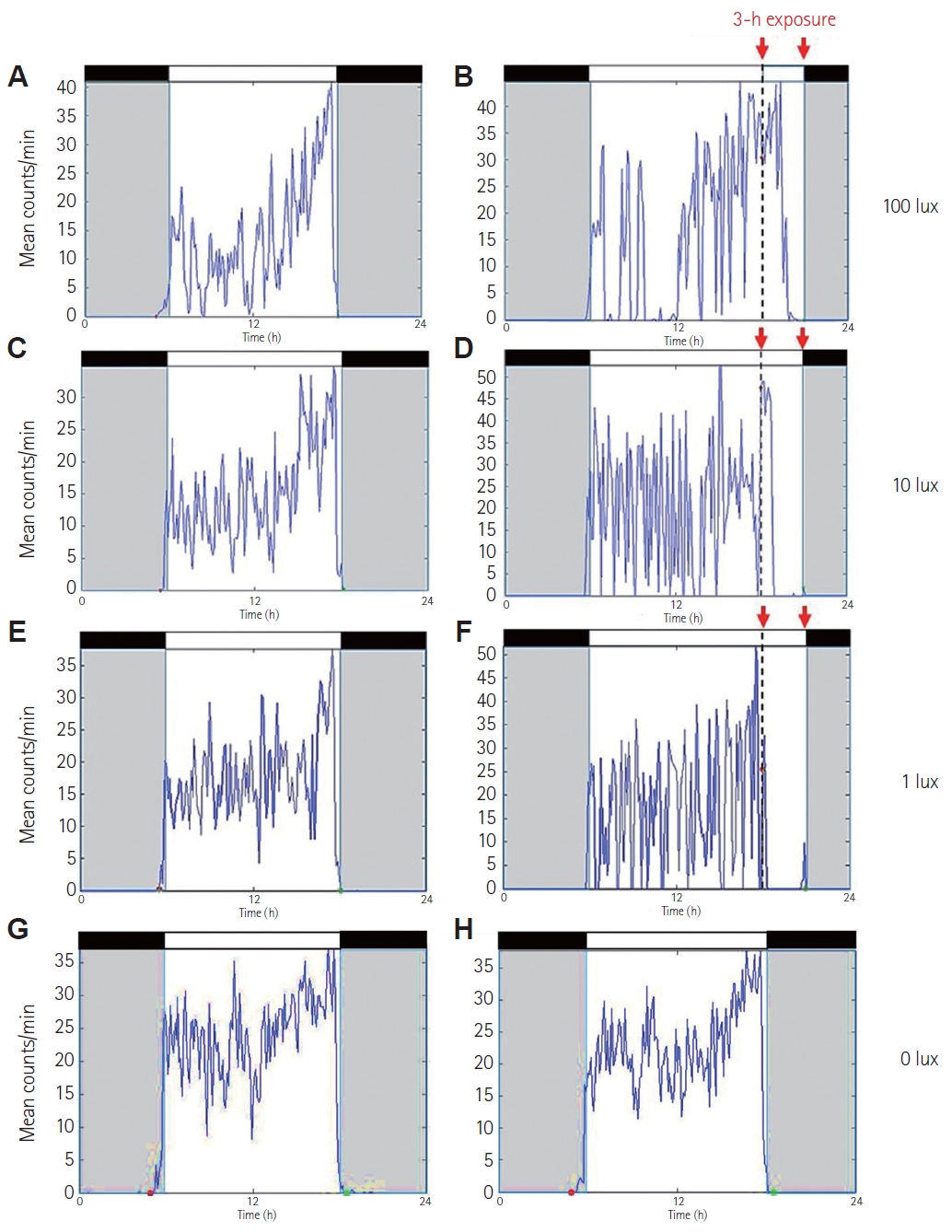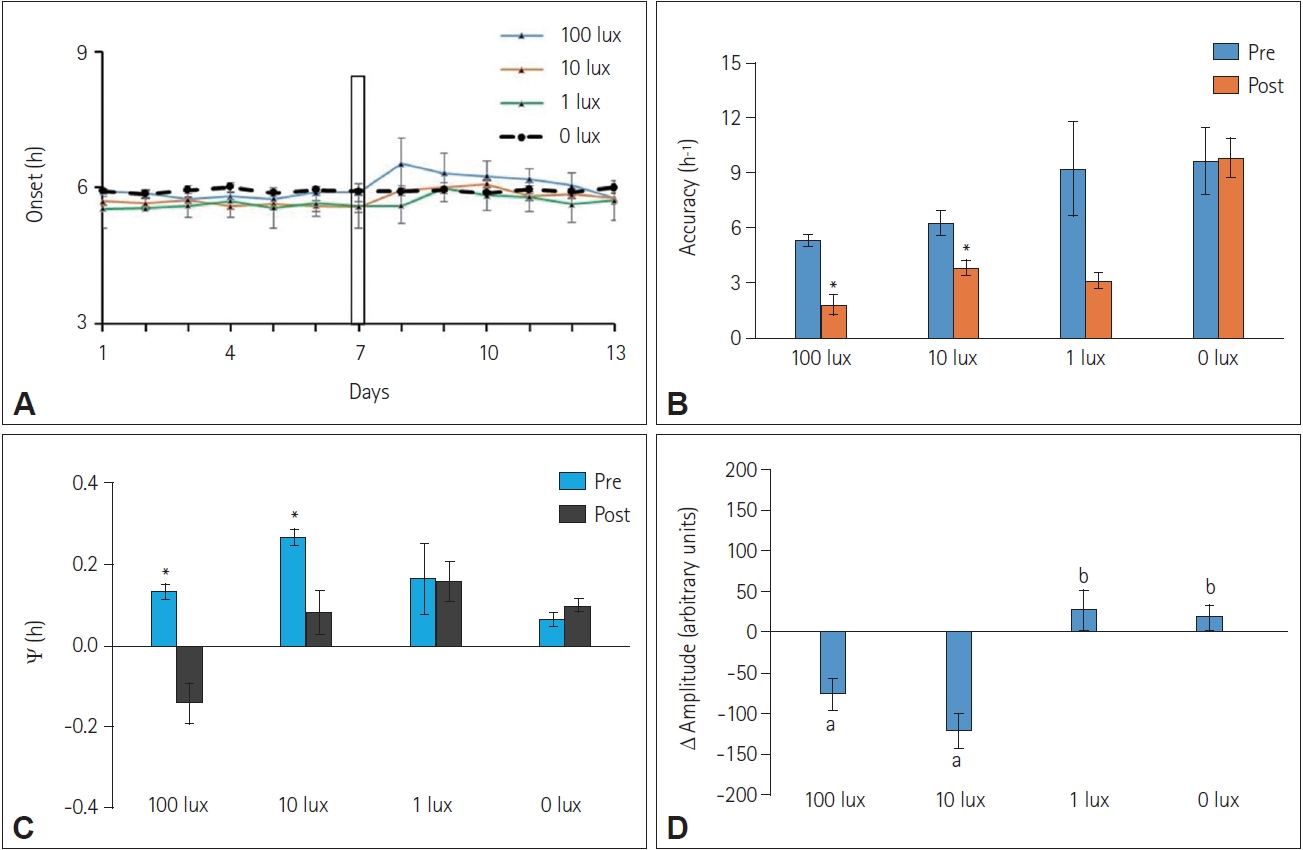1. Barak O, Kronfeld-Schor N. Activity rhythms and masking response in the diurnal fat sand rat under laboratory conditions. Chronobiol Int 2013;30:1123–1134.


2. Hut RA, Kronfeld-Schor N, van der Vinne V, De la Iglesia H. In search of a temporal niche: environmental factors. Prog Brain Res 2012;199:281–304.

3. Kronfeld-Schor N, Dayan T. Activity patterns of rodents: the physiological ecology of biological rhythms. Biol Rhythm Res 2008;39:193–211.

4. Aschoff J. Exogenous and endogenous components in circadian rhythms. Cold Spring Harb Symp Quant Biol 1960;25:11–28.


5. Redlin U. Neural basis and biological function of masking by light in mammals: suppression of melatonin and locomotor activity. Chronobiol Int 2001;18:737–758.


6. Mrosovsky N, Thompson S. Negative and positive masking responses to light in retinal degenerate slow (rds/rds) mice during aging. Vision Res 2008;48:1270–1273.


8. Refinetti R. Enhanced circadian photoresponsiveness after prolonged dark adaptation in seven species of diurnal and nocturnal rodents. Physiol Behav 2007;90:431–437.


14. Foster RG, Kreitzman L. The rhythms of life: what your body clock means to you! Exp Physiol 2014;99:599–606.


17. Garcia-Saenz A, de Miguel AS, Espinosa A, Costas L, Aragonés N, Tonne C, et al. Association between outdoor light-at-night exposure and colorectal cancer in Spain. Epidemiology 2020;31:718–727.


18. Kloog I, Haim A, Stevens RG, Portnov BA. Global co-distribution of light at night (LAN) and cancers of prostate, colon, and lung in men. Chronobiol Int 2009;26:108–125.


19. Grundy A, Sanchez M, Richardson H, Tranmer J, Borugian M, Graham CH, et al. Light intensity exposure, sleep duration, physical activity, and biomarkers of melatonin among rotating shift nurses. Chronobiol Int 2009;26:1443–1461.


20. Obayashi K, Saeki K, Iwamoto J, Okamoto N, Tomioka K, Nezu S, et al. Effect of exposure to evening light on sleep initiation in the elderly: a longitudinal analysis for repeated measurements in home settings. Chronobiol Int 2014;31:461–467.


21. Martin JS, Hébert M, Ledoux E, Gaudreault M, Laberge L. Relationship of chronotype to sleep, light exposure, and work-related fatigue in student workers. Chronobiol Int 2012;29:295–304.


22. Bedrosian TA, Fonken LK, Walton JC, Haim A, Nelson RJ. Dim light at night provokes depression-like behaviors and reduces CA1 dendritic spine density in female hamsters. Psychoneuroendocrinology 2011;36:1062–1069.


27. Rajeev C. Behavioural ecology of five striped squirrel Funambulus pennantii [dissertation]. Varanasi, Banaras Hindu University. 2018.
28. Portaluppi F, Smolensky MH, Touitou Y. Ethics and methods for biological rhythm research on animals and human beings. Chronobiol Int 2010;27:1911–1929.


29. Basu P, Singaravel M. Acceleration of re-entrainment during a 6-h acute jet lag simulation by 5-hydroxy-l-tryptophan in pygmy field mice. Biol Rhythm Res 2013;44:856–861.

32. Vivanco P, Rol MA, Madrid JA. Two steady-entrainment phases and graded masking effects by light generate different circadian chronotypes in Octodon degus. Chronobiol Int 2009;26:219–241.


33. Vivanco P, Otalora BB, Rol MA, Madrid JA. Dissociation of the circadian system of Octodon degus by T28 and T21 light-dark cycles. Chronobiol Int 2010;27:1580–1595.


34. Vivanco P, Rol MA, Madrid JA. Pacemaker phase control versus masking by light: setting the circadian chronotype in dual Octodon degus. Chronobiol Int 2010;27:1365–1379.


35. Mrosovsky N. Masking: history, definitions, and measurement. Chronobiol Int 1999;16:415–429.


39. Pendergast JS, Yamazaki S. Masking responses to light in period mutant mice. Chronobiol Int 2011;28:657–663.


40. Scheer FA, Ter Horst GJ, van Der Vliet J, Buijs RM. Physiological and anatomic evidence for regulation of the heart by suprachiasmatic nucleus in rats. Am J Physiol Heart Circ Physiol 2001;280:H1391–H1399.


43. Weinert D, Weinandy R, Gattermann R. Photic and non-photic effects on the daily activity pattern of Mongolian gerbils. Physiol Behav 2007;90:325–333.


44. Sharma VK, Chandrashekaran MK, Singaravel M, Subbaraj R. Relationship between light intensity and phase resetting in a mammalian circadian system. J Exp Zool 1999;283:181–185.


46. Hardeland R, Madrid JA, Tan DX, Reiter RJ. Melatonin, the circadian multioscillator system and health: the need for detailed analyses of peripheral melatonin signaling. J Pineal Res 2012;52:139–166.


47. Brainard GC, Lewy AJ, Menaker M, Fredrickson RH, Miller LS, Weleber RG, et al. Dose-response relationship between light irradiance and the suppression of plasma melatonin in human volunteers. Brain Res 1988;454:212–218.


50. Lupi D, Cooper HM, Froehlich A, Standford L, McCall MA, Foster RG. Transgenic ablation of rod photoreceptors alters the circadian phenotype of mice. Neuroscience 1999;89:363–374.


51. Lupi D, Semo M, Foster RG. Impact of age and retinal degeneration on the light input to circadian brain structures. Neurobiol Aging 2012;33:383–392.


54. Mahoney MM, Smale L, Lee TM. Daily immediate early gene expression in the suprachiasmatic nucleus of male and female Octodon degus. Chronobiol Int 2009;26:821–837.


55. Shuboni DD, Cramm SL, Yan L, Ramanathan C, Cavanaugh BL, Nunez AA, et al. Acute effects of light on the brain and behavior of diurnal Arvicanthis niloticus and nocturnal Mus musculus. Physiol Behav 2015;138:75–86.


60. Zhdanova IV. Melatonin as a hypnotic: pro. Sleep Med Rev 2005;9:51–65.


61. Hao H, Rivkees S. Melatonin does not shift circadian phase in baboons. J Clin Endocrinol Metab 2000;85:3618–3622.


62. Zhdanova IV, Geiger DA, Schwagerl AL, Leclair OU, Killiany R, Taylor JA, et al. Melatonin promotes sleep in three species of diurnal nonhuman primates. Physiol Behav 2002;75:523–529.


63. Zhdanova IV, Wurtman RJ, Regan MM, Taylor JA, Shi JP, Leclair OU. Melatonin treatment for age-related insomnia. J Clin Endocrinol Metab 2001;86:4727–4730.


64. Golombek DA, Escolar E, Burin LJ, De Brito Sánchez MG, Cardinali DP. Time-dependent melatonin analgesia in mice: inhibition by opiate or benzodiazepine antagonism. Eur J Pharmacol 1991;194:25–30.


65. Kumar D, Soni SK, Kronfeld-Schor N, Singaravel M. Wheel-running activity rhythms and masking responses in the diurnal palm squirrel, Funambulus pennantii. Chronobiol Int 2020;37:1693–1708.


66. Soni SK, Kumar D, Singaravel M. Melatonin-induced phase and dose responses in a diurnal mammal, Funambulus pennantii. Chronobiol Int 2020;37:641–651.


67. Kohyama J. A newly proposed disease condition produced by light exposure during night: asynchronization. Brain Dev 2009;31:255–273.


68. Driesen K, Jansen NW, Kant I, Mohren DC, van Amelsvoort LG. Depressed mood in the working population: associations with work schedules and working hours. Chronobiol Int 2010;27:1062–1079.


70. Parkes KR. Shift work and age as interactive predictors of body mass index among offshore workers. Scand J Work Environ Health 2002;28:64–71.

















